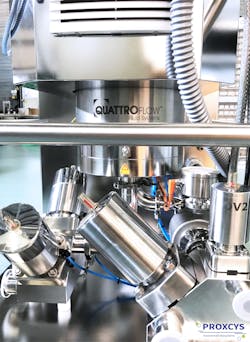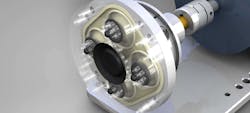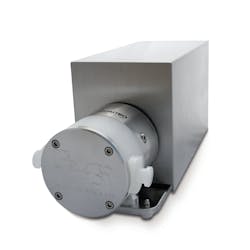Optimizing control of pump-related biopharma production processes
While large-scale manufacturing of biopharmaceutical drugs is often fully automated, process development and small-scale manufacturing often still require manual interaction and control steps. This not only demands continuous monitoring by operators, but sometimes results in a lack of consistency in the process. Achieving a higher level of accuracy and consistency is more achievable if the operation’s liquid-processing system possesses automated capabilities that can identify and tune into the proper manufacturing parameters.
In years past, this would mean that the lab technicians, chemists or biologists that were tasked with conducting, for example, a tangential flow filtration (TFF) process — few of whom were trained production engineers — would visibly observe the flow and pressure rates of the system’s pumps. They would then manually readjust them if either moved outside the limits of the operational parameters. Failure to note flow or pressure deviations could have severe repercussions, including unknown impact on the end product and pump breakdowns that would lead to production-crippling downtime.
In this white paper, we will illustrate how a new technology — the integrated pump controller — can be used to optimize pump performance in biopharma manufacturing activities by giving the operator the ability to automatically control such parameters as flow and pressure. This control will make it easier to run simple process steps in biopharma applications more effectively, resulting in better consistency, which is imperative when manufacturing products that must adhere to strict process conditions to create a safe, useable end-product.
The challenge
In the global biotech industry, the menu of end products continues to expand. Beginning with what are now seen as small-molecule pharmaceuticals, the market has grown to include such things as advanced biologically derived drugs, known as biologics, that have the potential to play a role in the development of blockbuster drugs that can treat a wide variety of diseases. All these products came to life through initial clinical-trial phases and the biologically derived drug itself likely ran through the entire scalability pipeline, from small-batch production and testing to eventual full-scale manufacturing.
Biological processes, like in our human body, run in the aqueous-liquid phase. Therefore, biologically derived drugs like proteins or monoclonal antibodies are also produced in aqueous media where pumps play a critical role in their manufacturing processes. Manufacturers have been searching for the best pumping technology to incorporate — namely one that must be able to deliver accurate flow rate and pressure conditions while minimizing negative impact on the end product or contamination thereof. The targeted list of the proper pump’s operational characteristics includes:
- High consistency in flow and pressure, resulting in low pulsation.
- High purity and sterility to prevent contamination of the product.
- Low levels of leachables and extractables.
- Linear flow performance at varying rates and pressures to optimize controllability.
- Low shear to minimize product damage.
- Self-priming design.
- Minimal heat addition to minimize excessive heating of the product.
- Hygienic design and cleanability.
Another variable that has expanded the number of pump choices has been the creation and increased acceptance — particularly among quaternary (four-piston) diaphragm pumps — of single-use versions that feature disposable pump chambers. The main benefit of single-use pumps is that there is no need for complex cleaning, which significantly reduces water and energy consumption and shortens production stops between batches.
In biopharma production, pumps are used in a variety of critical processing steps, most notably for liquid transfer that requires the creation and adherence to a required flow rate and pressure level. A common example of this is the filtration of a liquid in an application where a pressure setpoint must be maintained. While this can be done manually through the reading of a pressure gauge and adjusting the motor speed if the pressure should venture outside of the acceptable range, this way is both time-consuming and lacks the precision that an automated system can provide.
Automated pumps became viable after they were able to be outfitted with a programmable logic controller (PLC). In semi- or fully automated manufacturing processes, the PLC uses sensors to read parameters like the pump’s flow rate and pressure levels during operation and then automatically adjusts those parameters through increases or decreases in the pump’s motor speed if they move out of the required range. However, adding a PLC increases the complexity and cost of the pump’s operation since it requires knowledge of software programming and setup, additional wiring and configuration expenses, and a human-machine interface (HMI).
The algorithm that processes the sensor readings and controls the output signal (e.g., for pump motor speeds) is the PID controller, where PID stands for a proportional-integral-derivative. PID controllers are a piece of software that runs on PLC´s and works in conjunction with external flow and pressure sensors. The PID tracks, for instance, the pressure setpoint that is defined by the operator, and as soon as the pump starts, the speed is adjusted until the target pressure is reached. Whenever process conditions change, the pump speed is automatically adjusted and monitored by the PID until the required pressure setpoint is reached again.
During operation, a pump outfitted with a PID controller continuously calculates a predetermined error value, which is the difference between the required operational setpoint and a process variable. If the error value is exceeded, the PID controller corrects it based on the pump’s proper operational proportional, integral and derivative setpoints, which gives the controller its “PID” moniker. An everyday example of a PID controller is a motor vehicle’s cruise-control function. With cruise control in operation, as the vehicle ascends or descends a hill, the PID controller quickly adjusts the engine’s power output so that the vehicle can maintain the pre-set speed despite the change in driving angle.
The benefits that PID controllers can offer are widely used, with the developers of the pumps used in those applications addressing a new challenge — create a pump that can incorporate and take advantage of the ways that PID controllers can improve production systems.
The solution
One pump manufacturer that has risen to the occasion in the PID-enabled pump realm is Quattroflow Fluid Systems, GmbH, Duisburg, Germany, a product brand of PSG, a Dover company. Quattroflow, a leading developer of multi- and single-use quaternary diaphragm pump technology, has taken pump control in biotech-manufacturing applications to a higher level with the creation of the Q-Control Integrated Pump Controller.
Q-Control has been designed to circumvent the difficult installation and setup of a separate PLC, as the PID controller has been integrated into the pump itself while possessing the ability to directly interface with pressure and flow sensors. This minimizes the need for manual intervention in process applications as the pump can automatically adjust its motor speed in order to meet desired flow and pressure conditions, or, in extreme instances, automatically stop the pump’s operation when a high-pressure event occurs thanks to its internal-alarm function.
The Q-Control offers several different operational modes that can be used as needed in different biotech-processing conditions. Very helpful is its integrated Autotune function. This function makes it easier to find and set the correct parameters to configure the PID controller, which can be specific depending on process setups. When Autotune has started, the pump speed oscillates, allowing the sensor to determine an optimized set of PID parameters that will enable more stable and accurate pump control. Another standout feature of Q-Control is its Process Alarm, which can define a specific alarm for every connected sensor so that if the pressure exceeds a certain setpoint the pump will automatically cease operating. Additional sensors can also be added as needed; for instance, a level sensor can be used that will perform an automatic pump-stop condition when the tubing goes empty.
Q-Control is available for use on Quattroflow’s QF30, QF150, QF1200, QF2500 and QF440 multi use and single-use pump models. Q-Control can be connected to up to four analog and two digital inputs, which includes various types of flow, pressure, level and diaphragm sensors, as well as start/stop switches. In addition, an RS485 Modbus communication port allows remote operation and full access to parameters and process values.
Finally, Q-Control has the capability to monitor trend data and alarm logging, while also allowing remote operation. During all of Q-Control’s different operational modes, trend data like pump speed and sensor readings is logged into a historical file that can be reviewed later on a personal computer. This access to operational data gives the user an easy-to-read look into the pump’s run history.
The bottom line is that Q-Control now gives the user more control over pump operations in such critical and common biotech-manufacturing applications as TFF and virus filtration. In previous manual TFF setups, the operator would need to visually read the flow value on a flowmeter, manually adjust the pump speed until the correct flow rate was achieved and then periodically check to see that the flow rate had not ventured outside the required range. In virus filtration applications, a pressure sensor can be linked to the PID controller where it will read the pressure value and — if the pressure moves outside a safe operating range — automatically adjust the pump speed until the pressure returns to the proper point.
Conclusion
Even though the biotech industry is extremely modern and developing quickly, for various reasons, manual pump controls are still used. Until now, the only way to automate a pump was through the use of a PLC and programming a PID algorithm. The new Q-Control Integrated Pump Controller from Quattroflow essentially has the PLC and PID integrated into its design. By seamlessly interfacing with the pump’s flow, pressure, diaphragm and level sensors, the user can precisely select, set, monitor and control its operational parameters automatically, which results in direct control of pump operation while promoting more operational safety.
Dr. Andreas Frerix is the product manager for Quattroflow at PSG Germany GmbH. Dr. Frerix can be reached at [email protected]. Based in Duisburg, Germany, Quattroflow offers a full line of positive displacement multi-use and single-use quaternary (four-piston) diaphragm pumps and accessories for use in the biotech industry. Quattroflow is a product brand of PSG, a Dover company.



